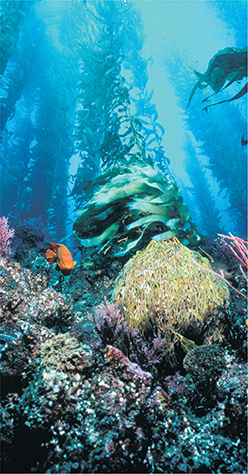Changes With Depth
Conditions in the ocean, such as the amount of sunlight, temperature, and pressure, change as you move from the surface to the ocean floor.  Light and temperature decrease with depth, whereas pressure increases.
Light and temperature decrease with depth, whereas pressure increases.
Sunlight decreases with depth in the ocean. The deep ocean is totally dark. Light cannot penetrate deeper than about 200 meters.
Water temperature decreases with depth. The top 100 to 500 meters of the ocean are well mixed and relatively warm in the temperate and equatorial zones. Deeper water is much colder and denser. Deep water moves very slowly, and does not interact much with the surface layer.
Pressure increases continuously with depth in the ocean. At a depth of 500 meters, the pressure is about 50 times greater than atmospheric pressure at sea level. Few forms of life can tolerate such great pressures.
Figure 26 Kelp forests such as this one off the coast of California occur in coastal waters swept by cold ocean currents. Light can penetrate to the floor of the continental shelf in this region, allowing the long strands of kelp to grow in nutrient-rich waters.

The Ocean Floor
What would the ocean floor look like if all the water were drained from the oceans? First you would see the continental shelf. This gently sloping plain forms an apron of shallow water along the edges of most continents. Beyond the continental shelf, the continental slope descends more steeply to the floor of the deep ocean. In places, you would see deep canyons cutting through the continental shelf and slope.
The ocean floor itself is a vast, flat plain dotted with volcanic peaks. You would also see the mid-ocean ridges winding through the ocean basins, and deep trenches along the edges of some oceanic plates. The deepest point in the ocean is in the Mariana Trench, more than 11 kilometers below sea level. Overall, the oceans have an average depth of 3.8 kilometers!
Ocean Currents
Ocean currents, shown in Figure 27, are the patterns of flow in Earth's oceans. Because of these currents, water flows from one ocean to another. Ocean currents are affected by winds, Earth's rotation, and the positions and shapes of the continents.
Surface Currents
Have you ever tried to cool a cup of hot chocolate by blowing across it? If you have, then you have imitated the way that winds move currents near the ocean's surface. A surface current is a large stream of ocean water that moves continuously in about the same path.  Winds blowing across the surface of the ocean cause the continuous flow of surface currents.
Winds blowing across the surface of the ocean cause the continuous flow of surface currents.




